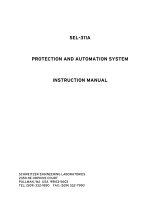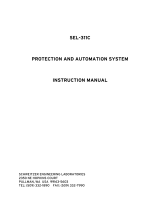Page is loading ...

1
Product Information
BRE Relay
Combi device with Binary input/output, 1-gang
TK BRE 1 U
Safety instructions
!
Assembly, installation, and commissioning must only be carried out by a qualified
electrician!
For work on systems with 230 V AC mains current the safety requirements of DIN VDE
0100 must be observed.
When installing DCM BUS systems the general safety rules for telecommunication
systems in accordance with VDE 0800 must be observed:
• separate cabling for high and low voltage lines
• minimum distance of 10 cm for joint cabling arrangements,
• use of separators between high and low voltage lines in joint cable ducts,
• use of standard telecommunication cables, e. g. J-Y (St) Y with 0.8 mm² cross section
• Consider loop resistance of existing wires in retrofittings
• To prevent electric shocks at the relay contact, disconnect the mains before working
on the device
• The device has to be installed into a flush-mounted wall box
!
Suitable lightning prediction must ensure that a voltage of 32 V DC will not be
exceeded at the DCM BUS wires a and b.
Important note for commissioning
!
The relay contact might have moved during transport caused by vibrations.
(NO-COM closed). To move the contact into idle position, connect the device to the
DCM installation and turn on the power supply.

2
Application / Brief description
Application
• Output for switch functions and input to trigger control functions
• Floating switching contact (make+ break) for mains voltage
• Binary input to trigger BUS functions with a push-button contact
• Installation into wall box
• 3-wire technique (a, b and P)
• 2-wire technique possible with max. 3 devices (TK BRE 1 U)
Brief description
• Evaluation of BUS commands
• Timer functions, on-delay, dropout delay,
• Toggle function (latching relay)
• Programmable functions for relay contact and binary input
• Direct switching of the relay contact with the binary input
• Trigger BUS commands with the binary input
• Trigger commands to the binary input with make and break contacts
• Trigger the relay contact with:
– bell button of the outdoor station
– floor door bell button / door release button / function button of an indoor station
– opening or closing the binary input
– control commands with on-delay
• Reset the relay contact with:
– control commands with dropout delay
– Reset commands
– new control command (toggle function)

3
Programming
Manual programming
Switching time of the relay contact: 0.5 to 128 s
The factory setting is 1 second
The relay contact can be triggered by:
• "calling" the serial number of the BRE relay
• floor door call, door call and internal call to the serial number of the BRE relay
• a door release with serial number, the beginning of a communication and control
function of a serial number
•
Function of the binary input:
• as a make contact to generate the required BUS protocol
• trigger the relay contact
Additional programming with Commissioning Software
Switching time of the relay contact:
• dropout delay up to 30 min or infinite
• on-delay up to 30 min
The relay contact can be triggered by:
• the beginning of a communication to an outdoor station
• the end of a communication
• second serial number
• control function and door calls of 10 further serial numbers
Flip-Flop function, Toggle function
Combination of various relay switch functions
Programming block setting possible
Function of binary input:
• as a break contact to generate the required BUS protocol
• trigger the relay contact

4
Device overview
Wiring and installation
Installation
Installation into flush wall boxes
!
Note! Max. permitted length for wires connected to the binary input : 2 m
Cross section and diameter for connected wires
Terminal Cross section Diameter
BUS terminals, binary input terminals 0.12 ... 0.5 mm
2
0.4 ... 0.8 mm
Relay contact terminals 0.5 ... 1.5 mm
2
0.8 ... 1.4 mm
• Connect the wires regarding the wiring diagram.
!
3-wire technique: Remove the jumper (see device overview)!
BUS-terminals, Binary input terminals Relay contact terminals
P
b
a
BUS
terminal
Binary input
terminals
Jumper
Relay contact terminals
Prog LED
Run/Prog button

5
Commissioning
!
The total current of the indoor stations, outdoor stations and other devices may not ex-
ceed the output current I(P) of the power supply and control units.
• Install all devices of the DCM system
• Short-circuit test for a-, b- and P-wires
• Switch on supply voltage
• Program the DCM installation (see manual of the outdoor station)
• Program the additional functions of the BRE relay
• Program the system manually or with the commissioning software
Technical Data
Supply voltage: +24 V ± 8 % (Power supply & control unit)
Housing: plastic
Dimensions: 52 x 52 x 23 mm
Weight: 32 g
Admissible ambient temperature: -20 °C ... +50 °C
Input current (binary input): 2.5 mA
Input current (2-wire): I(a) = 1.5 mA without load
Input current (3-wire): I(a) = 0.4 mA, I(P) = 2.8 mA without load
Max input current (3-wire): I(Pmax) = 4.4 mA
Relay contact: AC 230 V~, 50 - 60 Hz / 3 A
Max. current of input contact: 2.5 mA
Min. action time at binary input: 100 ms
Manual programming
Caption
briefly pressing slow flashing LED
press button until …. LED permanent illuminated
release button

6
Assign the relay contact to a bell button
1) Initiation
Briefly press the PROG-button (<1s)
of the power supply and control unit
The LED of the supply and control unit and the outdoor station
are flashing. Now the system is in programming mode.
2a) Assign the relay contact to a non-programmed bell button
TK BRE 1 U
Briefly press the PROG-button (<1s)
of the BRE relay until the LED starts flashing
2)
Briefly press the selected bell button (<1s) on the outdoor station. You
can hear a positive acknowledge tone at the outdoor station
1)
2b) Assign the relay contact to a programmed bell button.
This programming assigns a second serial number to the bell button.
TK BRE 1 U
Briefly press the PROG-button (<1s)
of the BRE relay until the LED starts flashing
2)
◄6s►
◄6s►
Press the bell button until …
you can hear a Prog2-tone and …
a NoProg- tone and ...
... a positive acknowledge at the outdoor station.
1)
(The period between the tones is approx.. 6 seconds)

7
3) Finishing
Briefly press the PROG-button (<1s)
of the power supply and control unit
The LED of the power supply and control unit and the outdoor station
are permanently illuminated. Programming mode of the system is
deactivated. The system is in idle mode.
Delete the programming
Before you can program a bell button you have to delete the existing programming.
1) Initiation
Briefly press the PROG-button (<1s)
of the power supply and control unit
The LED of the power supply and control unit and the outdoor station
are flashing. Now the system is in programming mode.
2) Delete
Press the bell button of the outdoor station.
◄6s►
Press the bell button until …
you can hear a Prog2-tone and …
then a NoProg- tone (after approx. 6s)
1)
IF the bell button was not programmed you will NOT hear the long Prog2-tone but you can hear
the NoProg-tone after 6s.
Release the bell button.
3) Finishing
Briefly press the PROG-button (<1s)
of the power supply and control unit
The LED of the power supply and control unit and the outdoor station
are permanently illuminated. Programming mode of the system is
deactivated. The system is in idle mode.
!
The deleting process eliminates all assignments of the bell button.

8
Assign the relay contact to a BUS action
TK BRE 1 U
Briefly press the PROG-button
of the BRE relay until the LED is illuminated
Now press the desired button in the system, which shall trigger the
BRE relay, e.g.:
Bell button, door release button, floor bell button, communication
button, function button (assigned with a control function)
Briefly press the PROG-button (<1s) of the BRE relay to finish the
process. Now the desired button is assigned to the BRE relay.
1) If instead a programming block tone is audible, the outdoor station has been given a programming block.
The programming block can only be cancelled with the commissioning software.
2) the BRE relay turns back into idle mode automatically after 30 s and the LED extinguish. If you want to cancel the
programming turn of the programming mode at the power supply and control unit.
This programming is possible with all protocols which transmit a serial number.
If you trigger a programmed bell button, you assign the BRE relay to this door call.
In this case you do NOT program the bell button. If you trigger the door release button of
an indoor station, the BRE relay will be assigned only to the button of this indoor station
and NOT to the door release command of all indoor stations.
This enables e.g. a selective authorisation for door release.

9
Set the switching time of the relay contact
Briefly press the PROG-button (<1s)
of the BRE relay until the LED starts flashing
Now press the PROG-button as long as the relay contact shall be
active (Example: Press the PROG-button for 2.5s. The switching time
will be 2.5s).
Release the button after the desired time and the LED extinguish.
Now the switching time is set.
Assign an action to the binary input
Briefly press the PROG-button
of the BRE relay until the LED is illuminated
Now trigger the desired BUS action, e.g. door release, floor bell button
or …
Press the PROG-button of the BRE relay until the LED flashes once.
Now the binary input is assigned to a BUS action.
Adjust the basic setting
1
:
Switching time of relay = 1 s; binary input transmits the door release protocol AS = 0
Briefly press the PROG-button
of the BRE relay until the LED is illuminated, then release the button.
Now press the PROG-button until the LED extinguish, then shortly lit
and then extinguish again.
Release the button.
1) The basic setting is equal with the state of delivery. IT only reset the manual programming. It will not reset the
programming of the Commissioning Software.

10
Acceptance of guarantee
We accept the guarantee in accordance with the corresponding legal provisions.
Please return the unit postage paid to our central service department giving
a brief description of the fault:
ALBRECHT JUNG GMBH & CO. KG
Service-Centre
Kupferstr. 17-19
44532 Lünen
Germany
Service-Line: 0 23 55 . 80 65 51
Fax: 0 23 55 . 80 61 89
E-Mail: [email protected]
Technique (DCM)
Service-Line: 0 23 55 . 80 65 52
Fax: 0 23 55 . 80 62 55
E-Mail: [email protected]
Albrecht Jung GmbH & Co. KG
P.O. Box 1320
58569 Schalksmühle
Germnany
www.gb.jung.de
www.jung-catalogue.com
The
-sign is a free trade sign addressed
exclusively to the authorities and does not
include any warranty of any properties.
Technical subjects to change.
EN_BRE.doc
04/2011
00
/


